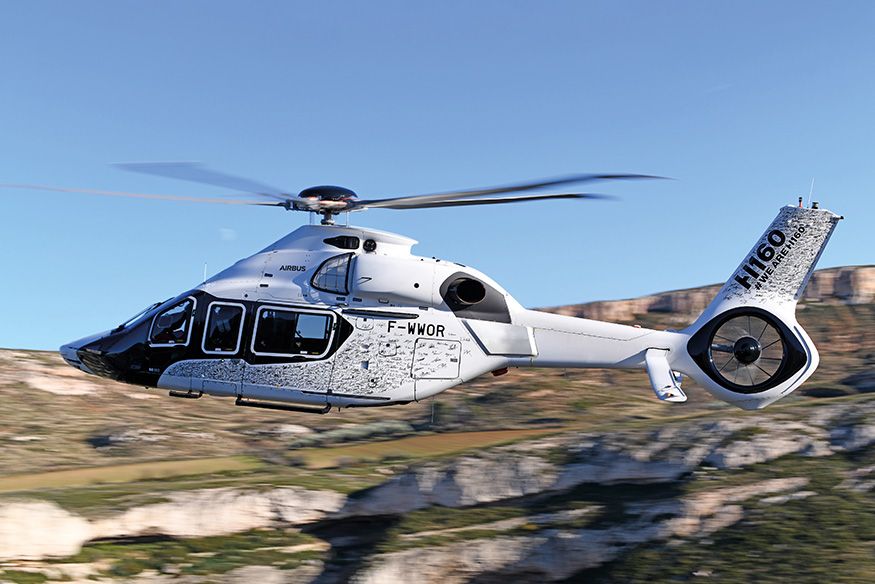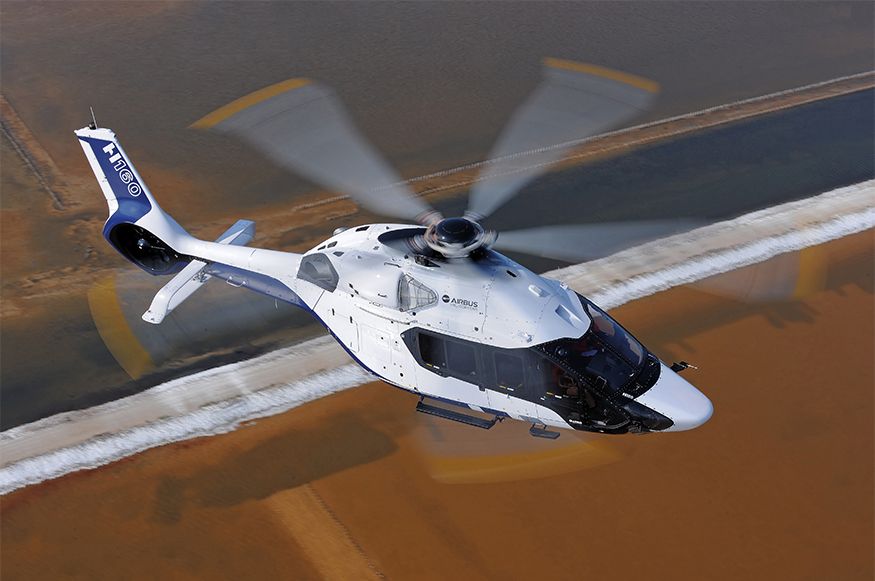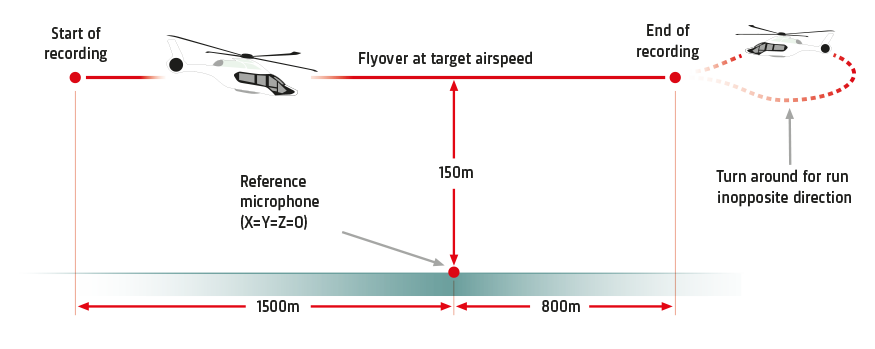Airbus - A Global Leader In Aeronautics and Space.
Airbus offers the most comprehensive range of passenger airliners from 100 to more than 600 seats and is a European leader providing tanker, combat, transport, and mission aircraft, as well as one of the world’s leading space companies. In helicopters, Airbus provides the most efficient civil and military rotorcraft solutions worldwide.
Quiet beyond belief
Last May, the Airbus H160 helicopter wrapped up its customer demos in Trenton, New Jersey.
Over four days, 52 customers including 23 pilots got to experience the new aircraft. Customers said they were blown away by the power, the sophistication of the auto-pilot, the low noise level, and smooth vibrations.
“It’s super quiet – quiet in start-up, quiet in cruise.
The maneuverability of the aircraft…it’s incredible."
Joe Drummelsmith of Union Holdings
Participant at Demo
The H160 helicopter falls into the “medium” category in size and performance, targeted towards VIP transport, oil-rig crew transfers, emergency medical services, and other commercial and industrial applications. It can seat up to 12 passengers and fly up to 460 nautical miles, with a VNE (never exceed speed) of 170 miles per hour. It burns 15 percent less fuel than previous-generation engines, and thanks to innovatively shaped rotor blades, the aircraft is significantly quieter than competitive models as measured from directly below.
Helicopter Noise Reduction
The noise measurements taken from the ground are part of an aircraft’s certification process (OACI Annex 16).
Before any civil aircraft can be put into service, it must be approved by authorities – European Aviation Safety Agency (EASA) in Europe and the Federal Aviation Administration (FAA) in the US. Noise certification is a measurement and calculation process in which Effective Perceived Noise Levels (EPNLs) must be generated for approach, take-off, and flyover operations.
The certification process is stringent and needs to be fulfilled early in the development phase to know the aircraft noise performance levels as they are important for Airbus customers, especially for Commercial Air Transport applications.
Under the responsibility of R. Corbiere, head of ‘On Aircraft Integration Tests’ within the Airbus Helicopters Test Centre, Airbus conducted the H160 certification tests at its testing facility at Marignane, France. Test procedures require stringent test-site selection and preparation, and regular acoustic calibration of the measurement system. This means that each test session requires a significant team, including flight crew, ground test personnel, and representatives from the certifying authority, and they need to be perfectly coordinated to make sure the instrumentation records all the tests during the first run.
Airbus Acoustic Test Specialist, G. Marrou, explains: “Each test run is quite expensive with the high cost of prototype flight hours and the cost of the human resources needed to pull it off. That’s why it’s so important that we get accurate measurements the first time around. Additionally, it is also important for us to reduce the installation time of the complete system on the field and the data processing time.”
Airbus chose to use Brüel & Kjær’s commercial-off-the-shelf (COTS) Aircraft Noise Certification Test System, which complies with ICAO technical standards for the measurement of aircraft noise certification levels.
With this system, all the necessary tasks, including calibration processes, corrections to reference day conditions, and measurement system responses are incorporated, so all the phases of the noise measurement process are completely supported.
Finally, the H160 acoustic certification test campaign took place in September 2017 and needed 75 flight runs to be recorded, 6½ flight hours over two days, with no technical defects on the measurement system. G. Marrou says,
“Once we have all the necessary measurements from the Brüel & Kjær system, we use dedicated developed validation software to integrate the flight path of the aircraft, temperature, and relative humidity in the air. With these final calculations, the official EPNLs are rendered and submitted to EASA for certification.”
LEARN MORE
DATA ACQUISITION MODULES
Measuring Equipment and Measurement stations
At the test facility, there are two stations: A measurement station and a test office station.
The measurement station houses the Brüel & Kjær ‘suitcase’ that contains the measuring equipment, including the battery-powered, data-acquisition modules and Brüel & Kjær microphones. The microphones are placed next to and 150 meters away from the suitcase. The measurement station provides Wi-Fi communication to the test office station and has a GPS antenna that enables the noise measurements to be synchronized with aircraft time and position.
The test is controlled from the test office station and real-time visualization of measured levels is available during the whole test. Operators can start and stop the remote measurement system and upload data from the measurement station for making calculations and reports. The test station can communicate with the aircraft to obtain position data as well as with a local weather station recording weather data at a height of 10m.
The helicopter takes off and flies a predefined route. An on-board system tracks where the aircraft is. The Brüel & Kjær system on the ground records noise while the aircraft is flying.
Recorded measurement data is corrected according to standards and is available immediately to be uploaded to the test office station. Finally, the field data can be made available for in-house or third-party software to make the official EPLN calculations.
Improving The R&D Process
Although the official EPNLs are first ready after the certification process, instant preliminary EPNLs are provided by the Brüel & Kjær system at any time for instant validation of the test. These are very useful during the R&D process as Airbus engineers can use them to make necessary noise-level improvements throughout.
In August 2018, EASA officially approved the acoustic certification for the H160. The first serial H160 performed its maiden flight on December 14, 2018. Certification is expected at the end of 2019 ahead of its entry into service 2020.G. Marrou says, “It’s extremely important to us to have access to accurate noise measurements during the R&D phase. It helps us know where we are in relation to the approved limits we need to meet and helps make our development process more efficient.”
With a large need for noise certification and internal noise testing, Airbus has been a customer of Brüel & Kjær for several decades. “We like that so much high-quality equipment is available off the shelf and still customizable to our needs – and of course that it is preapproved by the necessary authorities,” says G. Marrou, and continues:
“For us, there is huge value in getting the right measurements at the right time – with high reliability and continuous support.”

Abonnieren Sie unseren Newsletter zum Thema Schall und Schwingung




